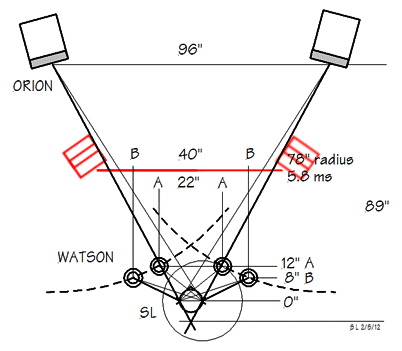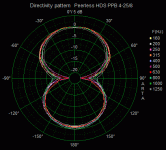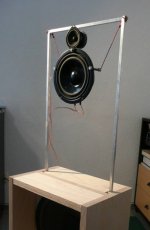I have moved my dipole speakers nearer to my listening position. Compared to the Watson situation they are at the red positions:

I found that I can have much of the claimed Watson advantages without the added hassle. When I leave the reverberation dominated distance by moving from reclined seating to a forward leaning position, the acoustic scene narrows from 90+° to 60°, sound images get nailed at their position and details abound.
Petty much what I suggested back around page 3 or where ever I commented. Oops, page 5. I.E. move the listening position closer to the speakers. Increase the level of the direct sound....
Last edited:
Rudolf, did you move closer to the speakers or the speakers moved closer to you?
I moved the speakers closer to me. I did not only want to reduce my distance to the speakers, but to increase the distance of the speakers to some walls too. This was quite effective in lowering the "noise floor" of the reflection free zone. Apart from the floor reflection everything in the Energy Time Curve is now at least 18 dB below the impulse peak.
If you are sitting closer to a wall than the speakers are, you might do better to move closer to the speakers.
Probably I need to emphazise that these are dipole speakers - with the acoustic scene (AS) way behind the speakers. I would not want the AS starting at the tip of my nose, which could happen with more conventional speakers.
Rudolf
You are right for very low frequencies. Perhaps I have to lower SPL below 50 Hz for 2-3 dB. But above 500 Hz my dipole patterns are fully developed at 0.5 m distance from the driver. This may be different for big planar speakers though.Right, moving the speakers closer.. but doesn't this contradict the dipole concept? I thought they needed quiet a bit of space to allow the dipole radiation fully.
Rudolf
You are right for very low frequencies. Perhaps I have to lower SPL below 50 Hz for 2-3 dB. But above 500 Hz my dipole patterns are fully developed at 0.5 m distance from the driver. This may be different for big planar speakers though.
Rudolf
Moving closer to a dipole source, the low frequency should increase relative to the higher frequencies. If you believe you have less bass it is probable a modal effect.
I've been listening to the Orions for 2 years now, I did try to listen closer to the speakers on a few occasions but left the 2.5m spread, will try your setting Rudolf this weekend. Yes, the bass was more and the recessed AS a bit more "palpable". Listening in the dark makes the effect even more realistic.
This a case for controlled directivity?

It is much about keeping the direct to reverberant ratio as high as possible, yes. But you want a fair (and controlled) amount of radiation to the front wall - to keep the acoustic scene at a distance. If you can align the dipole nulls with the first reflection points on the side walls, you are almost done.
Moving closer to a dipole source, the low frequency should increase relative to the higher frequencies. If you believe you have less bass it is probable a modal effect.
I have more bass. But I have issues with the stacked bass drivers too, which now aim more upward.
I've been listening to the Orions for 2 years now, I did try to listen closer to the speakers on a few occasions but left the 2.5m spread, will try your setting Rudolf this weekend. Yes, the bass was more and the recessed AS a bit more "palpable". Listening in the dark makes the effect even more realistic.

If the speaker moves closer, the distance between drivers and the baffle width could become an issue. I have tried to mount midrange driver and tweeter very close and to keep the baffle as small as possible.
And yes - you better close your eyes to believe what you hear.
I tried the near field position with only 50' speaker spread, did not work for me at all.. 
back to 100' spread, everything back in order, but listening slightly closer, around 70'. do I have to say the sound is unbelievably gorgeous? next step is to try the Watson..
If you can align the dipole nulls with the first reflection points on the side walls, you are almost done.
Would you mind giving more details?
back to 100' spread, everything back in order, but listening slightly closer, around 70'. do I have to say the sound is unbelievably gorgeous? next step is to try the Watson..
If you can align the dipole nulls with the first reflection points on the side walls, you are almost done.
Would you mind giving more details?
Last edited:
Try this explanation. but remember that the speakers have moved 40 cm closer to the listeninig position - making the direct response shorter/louder and most reflections later and farther away.
Sure, my wife loves them!!! 
More seriously, the Watsons are purely addictive, depending on the recording they just add an extra layer of believability making the illusion just more real.. more clarity, more dynamics, more precision. especially on masses -choral and orchestras-.
More seriously, the Watsons are purely addictive, depending on the recording they just add an extra layer of believability making the illusion just more real.. more clarity, more dynamics, more precision. especially on masses -choral and orchestras-.
Just discovered this thread, haven't read it all, but the comments met so far ring many bells. From my POV what this is all about is that the ol' ear/brain can do a fantastic job of unraveling a complex soundscape, that which is encoded in effectively every recording, if it gets enough of a helping hand.
And one way of achieving this is the Watson idea: I'm intrigued by the comments about the side speakers being totally, aurally invisible, this is one of my key markers for getting good sound, in a "straight", stereo setup.
Which is my way of saying that there is an alternative to the Watson arrangement; which is to lift the overall quality of sound coming from just the 2 normal, front speakers. If done to a sufficient degree, then those Watson "behaviours" will also manifest, and especially that of truly "invisible" speakers ...
Frank
And one way of achieving this is the Watson idea: I'm intrigued by the comments about the side speakers being totally, aurally invisible, this is one of my key markers for getting good sound, in a "straight", stereo setup.
Which is my way of saying that there is an alternative to the Watson arrangement; which is to lift the overall quality of sound coming from just the 2 normal, front speakers. If done to a sufficient degree, then those Watson "behaviours" will also manifest, and especially that of truly "invisible" speakers ...
Frank
my understanding is that you will probably not get the watson effect from a plain stereo setup.. the idea is to have a diffuse sound field some distance away, panoramic like if you like, and get the precision from a near field setup too.. that's how I see it, and how I experience it in my living room.
the Watsons do disappear if you set the volume right, they actually pull the auditory scene from the main speakers towards you, but it's a subtle effect, not "in your face" at all, and surprisingly everything keeps its shape, instrument size, placement and so on. so the higher the volume the stronger the effect until it falls appart and you can spot them away. I had an intoxicating experience with JMJ original Oxygene for example, the sound effects litterally travels around and away like in an almost 3D like sound bubble..
the Watsons do disappear if you set the volume right, they actually pull the auditory scene from the main speakers towards you, but it's a subtle effect, not "in your face" at all, and surprisingly everything keeps its shape, instrument size, placement and so on. so the higher the volume the stronger the effect until it falls appart and you can spot them away. I had an intoxicating experience with JMJ original Oxygene for example, the sound effects litterally travels around and away like in an almost 3D like sound bubble..
Last edited:
This whole thing is happening in the fascinating world of psychoacoustics, where the mind can pull a sound rabbit of the hat if you set up the props correctly.my understanding is that you will probably not get the watson effect from a plain stereo setup.. the idea is to have a diffuse sound field some distance away, panoramic like if you like, and get the precision from a near field setup too.. that's how I see it, and how I experience it in my living room.
the Watsons do disappear if you set the volume right, they actually pull the auditory scene from the main speakers towards you, but it's a subtle effect, not "in your face" at all, and surprisingly everything keeps its shape, instrument size, placement and so on. so the higher the volume the stronger the effect until it falls appart and you can spot them away. I had an intoxicating experience with JMJ original Oxygene for example, the sound effects litterally travels around and away like in an almost 3D like sound bubble..
With POS (Plain Ol' Stereo) the diffuse field is created from all the listening room reflections, the brain integrates this "surround" info nicely. The falling apart shouldn't happen if the system is tweaked or optimised sufficiently; what's happening here is that the audible distortion content is increasing to the point that the "live" illusion can't be sustained anymore; the mind gives up on "playing the game" of "forcing" the sound to match up with what the audible clues are saying is on the recording.
That 3D sound bubble is the end goal for audo playback; synthesizer albums should create absolutely mammoth soundstages if all's working correctly ...
Frank
I'm having trouble finding the thread where (I think it was him) Joachim used some small Tymphony/Vifa (TC9?) inexpensive drivers on the tops of plastic pipes near the seating positon as "filler speakers"? Can someone point me to that thread, where it is mentioned which model of drivers were used?
- Home
- Loudspeakers
- Multi-Way
- Linkwitzlab "Watson"
